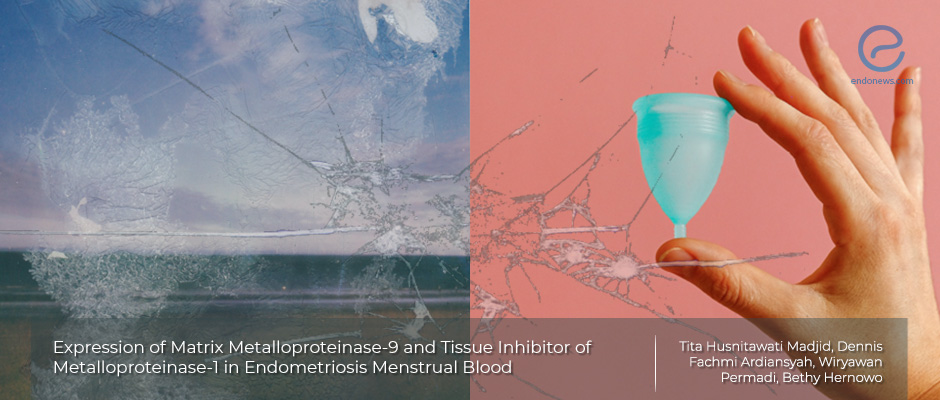Preferential expression of some membrane type matrix metalloproteinase proteins
Dr. Maoga and associates from academic institutions located in Germany and Kenya have published their findings on the immunohistochemical expression of MT-MMP proteins, namely MT2-MMP (MMP15) and MT3-MMP (MMP16) in the eutopic endometrium of healthy and endometriotic patients; and also…
Key Points Lay SummaryMatrix metalloproteinases and their role in endometriosis
The extracellular matrix harbors important macromolecules such as collagen and glycoproteins which are required for tissue remodeling, differentiation, and homeostasis. The main group of enzymes responsible for these properties is called matrix metalloproteinases (MMPs). It has been proven that MMPs…
Key Points Lay SummaryMenstrual Blood Proteins for Endometriosis Diagnosis
Endometriosis is a gynecological disorder characterized by endometrial tissue outside the uterine cavity. The backflow of menstrual blood from the uterus through the fallopian tubes is thought to be the cause of endometrial tissue growing outside the uterine cavity when…
Key Points Lay SummaryNew Protein for Endometriosis Diagnosis
A protein called TIMP3 (tissue inhibitor of metalloproteinase-3) could be used for the diagnosis and prognosis (likely course) of endometriosis. The early diagnosis of endometriosis is of paramount importance because it can help to diagnosis and thus initiate the right…
Key Points Lay SummaryAutophagy, proteolysis and Endometriosis
Sui et al., a group of researchers from the Qiqihar Medical University and Qilu Hospital of Shandong University, recently published in Experimental and Therapeutic Medicine. The piece titled “Expression and significance of autophagy genes LC3, Beclin1 and MMP-2 in endometriosis”…
Key Points Lay SummaryInterleukin 6 secretion from activated macrophages promotes the migration of endometriotic epithelial cells
Endometriosis is a chronic inflammatory disease. Accumulating evidence suggests that endometriosis patients have a higher level of various inflammatory factors which are associated with the pathogenesis of the disease. Several studies have shown marked increases in macrophage populations and activity…
Key Points Lay SummaryA Potential New Target for the Treatment of Endometriosis
A protein called STIP1 could be facilitating the migration of endometrial tissue outside the uterus, therefore, leading to endometriosis according to a study by Taiwanese researchers. The protein could, thus, be used as a potential therapeutic target for endometriosis. For…
Key Points Lay SummaryCCL19/CCR7 Interaction can Casue Characteristic Cell Proliferation
In their paper published in the American Journal of Reproductive Immunology titled “CCL19/CCR7 contributes to the pathogenesis of endometriosis via PI3K/Akt pathway by regulating the proliferation and invasion of ESCs,” Diao et al. hope to elucidate one of the mechanisms…
Key Points Lay SummaryThe Potential Molecular Mechanisms that Drive Endometriosis Progression
Endometriosis is a mysterious disease in that the exact mechanism that causes the illness is still at large. Yang et al. recently published a paper in the European Review for Medical and Pharmacological Sciences that hopes to elucidate the molecular…
Key Points Lay SummaryThe Endometrium Itself is Genetically Different in Endometriosis Patients
Researchers in China identified a number of genes that are differentially expressed in the eutopic endometrium of women with endometriosis and those without. The researchers think that these genes may be involved in the development of endometriosis and that they…
Key Points Lay SummaryCombination Therapy Proves More Efficient in the Treatment of Endometriosis
In their recent paper in British Journal of Pharmacology, entitled “Combination therapy with telmisartan and parecoxib induces regression of endometriotic lesions,” Nenicu et al. illustrate the increased effectiveness of telmisartan used along with a cyclooxygenase-2 (COX-2) inhibitor (a non-steroidal anti-inflammatory…
Key Points Lay Summary
 By Nasuhi Engin Aydin
By Nasuhi Engin Aydin

 By Eylül GÜN
By Eylül GÜN

 By Ellen Tumimbang
By Ellen Tumimbang

 By Özge Özkaya
By Özge Özkaya

 By Kasthuri Nair
By Kasthuri Nair

 By Dr. Youngran Park
By Dr. Youngran Park




